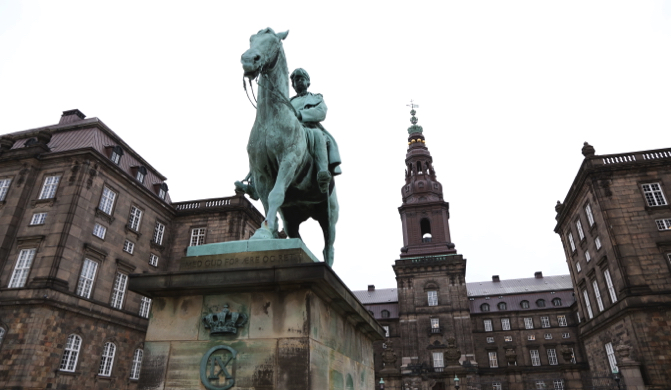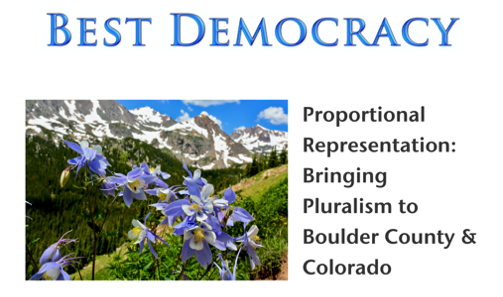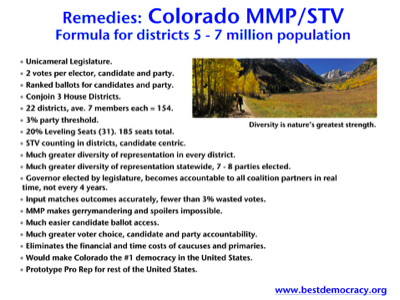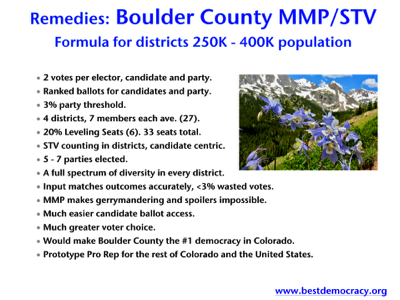”What Scandinavians call the Nordic model is a smart and simple system that starts with a deep commitment to equality and democracy. That’s two concepts combined in a single goal because, as far as they’re concerned, you can’t have one without the other.” - Ann Jones
What is Proportional Representation?
- Ernest Naville
Pro Rep draws a distinction between representation and decision making. Democracy requires that the decisions of a legislative body should be made by majority vote. Legislators themselves needn't be chosen by majority vote. In Pro Rep systems, each representative is elected by a share of the electorate large enough to deserve representation, determined by agreed upon thresholds.
In First Past the Post (FPTP) elections in Single Member Districts minorities (any minority, not just racial minorities) are excluded from having a voice in government. Proportional Representation (Pro Rep) in Multi Member Districts remedies the exclusion of large blocks of voters that occurs. Pro Rep provides a close correlation between the percentage of votes received for a particular group of candidates, represented by their party, and the percentage of seats that party then receives in government. With 49% of the vote, party "A" receives about 49% of the seats in Multi Member Districts. With 17% of the votes, party "B" receives approximately 17% of the seats.
Advantages of Proportional Representation
Our electoral systems are designed to concentrate power and exclude people. All the Proportional Representation systems are designed to disperse power and include nearly everyone.
• Faithfully translate votes cast into seats won.
• Encourage or require the formation of political parties or groups of like-minded candidates to put forward lists.
• Give rise to very few wasted votes. When thresholds are low, almost all votes cast in Pro Rep elections elect a candidate of
choice, faithfully preserving voter intent.
• Facilitate minority parties’ access to representation.
• Encourage parties to campaign beyond the districts in which they are strong or where the results are expected to be close.
• Restrict the growth of ‘regional fiefdoms’.
• Lead to greater continuity and stability of policy.
• Make power-sharing between parties and interest groups more visible.
Greater detail for the advantages at the Ace Project. To be fair, there are downsides to Pro Rep as well. The Ace Project link also has liabilities listed.
First Past the Post (FPTP) skews results, either excluding or over-representing voting blocks. In the US with FPTP, your vote coud be part of 49% for a party resulting in 0% or 100% of the representation. Many votes are wasted; many or most people go unrepresented, systemically excluded. FPTP by design excludes large blocks of the electorate from decision making. In Pro Rep systems, 49% of the vote counts toward 49% of the seats.
Knowing that their votes under FPTP are likely wasted, will not influence final outcomes, voters may have little incentive to vote in predetermined districts, suppressing voter participation. Inputs do not match outputs. Voter intent is not preserved.
There's a direct link between the type of election system, how well the social safety net functions, how prosperous people are, how they perceive corruption in their country and how happy they are. All of the countries that consistently score in the top five in the Economist Intelligence Unit's Democracy Index use variations of Proportional Representation, currently Norway, Iceland, Sweden, New Zealand and Denmark.
All PR systems offer easier candidate ballot access and greater voter choice than FPTP. Most countries use Party List systems that as it sounds, are party centric. Mixed Member Proportional (MMP) and Single Transferable Vote (STV) systems offer easier candidate ballot access and more voter choice. Uncontested elections are nearly non-existent. All Pro Rep systems result in more accountable government.
Three Major Variations of Proportional Representation
Each of the 94 countries that use PR has its own formula of arriving at proportionality. Most use some combination of three variations.
• In a Closed Party List system (party centric), the elector votes for a party's list of candidates instead of a single candidate. Each party then receives a share of the seats proportional to the share of votes it received. The party determines the list order, not the voters. CPG Grey produced an animated video describing how a variant of MMP with a closed list works.
• In a Single Transferable Vote (STV) system (candidate centric), voters rank their choice of candidates on the ballot instead of voting for just one candidate. STV is much less party centric. This 2 min. 11 sec. video explains STV counting methods. STV is more easily implemented where state laws prohibit candidates in municipal elections from declaring party affiliations. STV is also appropriate for non-partisan offices such as County Coroner and Judges.
Detailed descriptions of STV counting methods.
Written description of how STV functions.
• In an additional member Mixed Member Proportional (MMP) with an Open List system (mixed party and candidate), each elector casts two votes instead of one. On a double ballot, the elector chooses a party of choice and also his or her favorite candidate among those listed. It's also called an Open Party List system. As used in Australia, a horizontal line is drawn across the ballot with choices "Above the Line" for the party and "Below the Line" for the individual candidates. Voters can mix their party and candidate choices. It offers the greatest diversity of voter choice and makes individual candidates within a party accountable. It also precludes choke holds party bosses can exert on candidates in "Closed List" systems. With multiple parties fielding candidates, candidates also have more choice and much greater ballot access. If an office holder doesn't like the direction of a party, that individual can more easily move to another party. MMP offers easy candidate ballot access through a full spectrum of ideological viewpoints, offering voters a full spectrum of choice. New Zealand and Germany use MMP.
How Fine Grain Should People Be Represented?
Most electoral systems in the US were designed a century or longer ago when there were fewer people. Not only are the electoral systems out of date, the small size and districting methods of legislative bodies often concentrate power in very few elected officials, often from one party. Many districts have one party dictatorships for decades or generations. In the many conversations I've had with people, disgusted by elected officials they didn't vote for and may disapprove of, they often reject the idea of having more of what they dislike, politicians. The size of city councils, county commissions and state legislatures should be addressed as separate ballot issues from electoral systems, not conflated with electoral system change.
The fewer seats there are in any given legislative body, the fewer demographic slices are represented, the more power is concentrated. Conversely, the more seats in Multi Member Districts there are in any elected body, the lower the threshold for each seat, the more accurately the electorate is represented, the more power is dispersed in multiple parties. Fine Grain Proportional Representation disperses concentrated power and enables electoral input to more accurately match output.
Three variables determine how "Fine Grain" each demographic slice can be represented:
1) The number of members of an elected body.
2) How many members there are per district.
3) The threshold for a party to receive seats.
In the US the threshold is 50% or possibly lower when more than two candidates run for single member districts.
A rough grain Pro Rep system with a threshold of 25%, H.R. 4000 as introduced by Rep. Don Beyer D - VA, would result in a maximum of 4 parties with representation, more likely 3 parties. It's an imperfect start, but should be passed and implemented. Nearly every Pro Rep country has much lower thresholds for representation, usually 2% - 5%, resulting in 7 - 10 parties.
How Should We Decide?
We can learn from efforts to implement PR in British Columbia in a Nov. 2018 ballot initiative. The question was broken into two parts. The first was deciding whether or not BC's current FPTP system is broken and should be replaced with a PR system. The second question was deciding the best variation of three PR systems with which to replace FPTP if Question 1 passed.
Many British Columbia voters were confused by the three different PR systems, two of which were hybrid systems never before implemented in other countries or districts. Some of the implementation details were left ambiguous, to be determined after the election. The British Columbia Liberal Party used Fear, Uncertainty and Doubt (FUD) to exploit the confusing and ambiguous proposals. Premier Horgan was placed in the position of defending 3 not completely developed, complex voting systems, in one minute debate formats. The measure failed.
Lessons learned from the B.C. referendum:
• Pro Rep design details need to be finessed before presentation for public approval.
• The adoption of Pro Rep should be an up or down single question: Do we keep FPTP in Single Member Districts (or At Large block voting) or change to a Pro Rep model (Party List, STV or MMP) that more accurately represents our state, county or city?
Most of the world's countries use Proportional Representation.
Folketing (parliament) Building. Copenhagen, Denmark © 2017 Jesse Kumin, All Rights Reserved.
PR roots trace back to 1793, "when several schemes based on this principle were presented to the French National Convention by Condorcet and others. The types of P.R. in current use were developed about the middle of the 19th century." 3/4ths (21 of 28) of European Union countries use proportional representation. In Denmark, most people live in ten districts represented by an average of 13.5 Folketing members per district, with a 2% threshold for representation. 139 members are elected from districts with the remaining 40 adjustment seats leveling out the national party vote to match seat assignments per party. The relatively low threshold for seats of 2% facilitates more parties, 9 parties have representation.
In Sweden's Riksdag elections, 310 members are elected using "Open Party List" PR in 29 districts. About 25% of voters choose to just vote for a party, which orders its own list. The remaining 39 adjustment seats are distributed amongst the 8 parties which met the 4% threshold, to match Riksdag seat assignments to the percentage of votes received nationally, as closely as possible. Local elections usually follow the same model. Having someone you want to vote for (not against), increases voter turnout. Sweden's 9 Sept. 2018 election turnout of 87.18% was the highest in 33 years and 1.38% higher than 2014.
In Norway the threshold for representation is also 4% resulting in 8 parties. Norway is often at the #1 position in the EIU Democracy Index and on a host of other lists. The Netherlands has a 3/4th's of 1% threshold, resulting in 13 parties. In the US, we have a 50% threshold in Single Member Districts and two parties.
101 Members of the Estonian Riigikogu through six parties, represent 1,318,705 people, using Fine Grain Proportional Representation with a 5% threshold. Thresholds in the US can range from 15% for primary ballot access, to 50% for general elections. This results in a two party system, frequently with uncontested, one party dominant, predetermined elections.
View of Reykjavik and the harbor from the Hallgrimskirkja Cathedral.
Central Reykjavik © 2017 Jesse Kumin, All Rights Reserved.
Iceland has a slightly larger population: 348,580, than Boulder County, CO: 322,514. Iceland has 9 district members from each of 6 electoral districts. Another 9 adjustment seats are divided between parties based on how many people in Iceland voted for each party. Adjustment seats resolve discrepancies between seats won in the district elections and match each party to seats assigned by percentage of the total vote, MMP with an Open List. The "Althing" has 63 members from 7 parties. Women have about the greatest equivalency in pay, parliamentary representation, corporate board representation, overall equity, of any country in the world, using Fine Grain Proportional Representation.
Why Change?
Most of us in the United States do NOT live in a democracy. Boulder County, CO has had 3 County Commissioners from 1 party for over two decades, since 1994. This isn't unusual. Per a study by Colorado College emeritus professors Thomas E. Cronin and Robert D. Loevy, 82% of Colorado counties have one party dominant systems using FPTP. In Georgia, 83% of 2016 House races were uncontested. In 2018, per the Cook Political Report, most Congressional seats are either "safe" or lean toward one party or the other, two choices. Only 31 of 435 (7.1%) of Congressional districts are considered "Toss-Up" competitive seats. When most elections are predetermined years in advance, do we truly live in a democracy?
63 representatives, 7 parties in Iceland v. 3 representatives and 1 party rule in most Colorado counties. Which election sytem, FPTP with At Large or PR, more accurately reflects the electorate? Which system includes and represents the interests of more segments of the electorate? Which system offers greater ballot access to candidates and voter choice? Voters in Iceland have 7 parties using Fine Grain Proportional Representation. Voters in Denmark have 9 parties to choose from. Voters in the United States usually have one or two viable choices. Results are largely predetermined by system design.
The winner in November, 2018 of the Boulder County Commissioner's race, won his party's nomination in March with 0.17% of 1% of the active voters in the county, at the Democratic County Assembly. 4 other competing candidates fractured the vote and failed to meet the 30% threshold for ballot access in a one party county. Boulder County like so many other one party counties and cities across the US, uses First Past the Post, Single Member Districts, exacerbated by the At Large system. Is winning an election with 0.17% of 1% of the electorate determining an election outcome, a real democracy?
What might a Fine Grain MMP system in the US look like?
European MMP models don't currently exist in the United States. Cambridge, MA uses a rough grain version of STV.
PR systems can be implemented by initiative process, following the British Columbia two question model, in 22,000+ Home Rule cities and counties across the United States. "Good Governance Boards" can be established in cities and counties to identify problems with governance and elections, and recommend solutions.
MMP with an Open List, lots of seats producing Fine Grain representation, modeled after systems from Denmark and Sweden, with a more finely nuanced version of STV using Range voting for each candidate, might look like this:
• Regional districts retain local representation.
• MMP, mix and match parties and candidates. Vote for and rank as many candidates as you want.
• Fine Grain, lots of reps per district, full spectrum of opinion and interests represented. Denmark averages 13.5 reps in ten districts.
• 20% adjustment seats, match party seat assignments to votes per party. Inputs match Outputs.
• Open Lists to reduce party boss power, increase accountability of candidates to voters. Easier ballot access for candidates.
• 3% threshold to preclude very small splinter parties, but allow minor parties to be represented. Norway & Sweden are 4% (8 parties), Germany is 5% (7 parties), Denmark is 2% (9 parties), Netherlands is <1% (13 parties).
The MMP and STV systems below can be scaled up or down for larger or smaller populations anywhere, using the above formula.
• 4 district (6.75 seats per district) + 6 adjustment seats = 33 seat Mixed Member Proportional (MMP) Boulder County, CO, system pop. 322,514.
• 17 district (9.6 seats per district), + 33 adjustment seat = 199 seat Mixed Member Proportional (MMP) Colorado system, pop. 5,607,154.
• 25 seat Single Transferable Vote (STV) system for the city of Boulder, CO, pop. 108,090 at the bottom of the At Large page.
Additional Info
Read "A Case for Party List Proportional Representation" - Gary Swing
Essay Empire (brief history of PR): Proportional Representation
Another rationale for Accurate Democracy
Why Not Proportional Representation?
FairVote: Proportional Representation Library
Wikipedia: Proportional Representation
A Short History of STV in the US by Douglas Amy.
"Should the U.S. political system work more like other democracies? Should we increase the number of parties? Limit the terms of Supreme Court judges? Reduce the power of low-population states?" Jack Santucci Course Syllabus at Drexel.
Spread the Word, Propagate Pro Rep
Tell your friends, download and print the Best Democracy handout card pdf (1.2 MB).
Prints 8 up on a US legal 8.5" x 14" sheet, both sides (duplex). Best with 80# card stock. You can reach 400 people for the cost of one book.
Proportional Representation = Fair Representation
- Jesse Kumin
Helsingborg, Sweden a city of 142,793, has 65 members in their Kommunfullmäktige, from 8 parties, elected using "Fine Grain" Proportional Representation (Pro Rep).
Unless you read Swedish, if you click through to the Helsingborg site, go to the "Translate" button in the footer, bottom right.
Helsingborg City Hall © 2017 Jesse Kumin, All Rights Reserved.
Best Democracy Boulder County & Colorado Presentation (5.5 MB .pdf). This is a scalable formula. I will customize this presentation to any geography. Any district that adopts this system will be in the same league of democracies as New Zealand, Denmark and Ireland, after which the Colorado MMP/STV system is modeled. Please contact me. - Jesse
Sample Slide: Colorado MMP/STV







